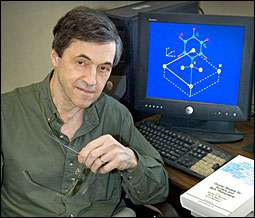Modeling the movement of electrons at the molecular scale

Finding more efficient ways of storing and using energy requires scientists to first look at the particles that set these fundamental processes in motion – the electrons. Controlling the movement of electrons through individual molecules could allow for the development of new technologies such as small-scale circuits to be used for a variety of applications including improved solar cells.
Marshall Newton, a theoretical chemist at the U.S. Department of Energy's Brookhaven National Laboratory gave a talk about the theoretical techniques used to understand the factors affecting electron transfer at the 232nd national meeting of the American Chemical Society.
Electron transfer plays a vital role in numerous biological processes, including converting energy from food into useful forms and nerve cell communication. It's also the initial step in photosynthesis, where charges are first separated and the energy is stored for later use. That natural process is one of the concepts behind energy production through solar cells.
"Essentially everything in everyday life is dependent upon electronic interactions," Newton said. "and in particular, we're working to sort out what makes the electrons move from molecule A to molecule B." Scientists like Newton are developing models to understand these interactions in molecular systems, where complex molecules communicate electronically across long distances.
A crucial issue in the electron transfer problem is the change in the positions of atomic nuclei that occur when a molecule or ion gains or loses an electron. Measuring these nuclear configuration changes is an essential part of understanding how the electrons move.
Working in the field for 30 years, Newton is currently focusing on modeling the effect of solvents on electron transfer. As a chemical reaction takes place among the molecules dissolved in solution, chemical bonds are broken and formed and electrical charge is redistributed among the molecules. The solvent environment responds to these changes in a way that strongly controls the energy cost for a successful electron transfer event.
What Newton is trying to develop is a quantitative theory that will allow scientists to reliably predict the probability, or "speed," of electron transfer. A theory with such "predictive power," as Newton calls it, could serve as a basis for designing molecular systems to improve upon photosynthesis and energy production in general. However, once scientists have an understanding of electron transfer itself, they still have to incorporate that knowledge into the chemical processes that surround it, Newton said.
"Electron transfer is just the first major step toward something even more important," he said. "Mechanistic understanding of electron transfer is going to give us an important part of the fundamental knowledge needed to achieve advances in energy technology. But the final goal is not electron transfer, it's making something new."
Source: Brookhaven National Laboratory





















